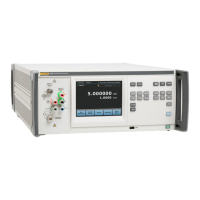5790B
Operators Manual
6-10
Table 6-5. Interface Messages Sent by the Product
Mnemonic Name Function
END End
A message that appears when the Product
asserts the EOI control line, which happens
when the Product transmits the ASCII character
LF for its termination sequence or terminator.
DAC Data Accepted Sets the handshake signal line NDAC low.
DAV Data Valid Asserts the handshake signal line DAV.
RFD Ready For Data Sets the handshake signal line NRFD low.
SRQ Service Request
A control line that can be asserted by any
device on the bus to indicate that it requires
attention. For details, see “Check the Product
Status.”
STB Status Byte
The response sent to a serial poll (SPE) by the
Product.
Use of *OPC?, *OPC, and *WAI
The *OPC?, *OPC, and *WAI commands are used to maintain control of the
order of execution of commands that could otherwise be passed up by
subsequent commands.
If a CAL_NEXT command has been sent, check to see if the calibration step has
completed by sending the query *OPC?. As soon as the calibration step has
completed, a 1 is shown in the output buffer. Always follow a *OPC? command
with a read command. The read command causes program execution to pause
until the addressed instrument responds.
The *OPC command is similar in operation to the *OPC? query, except that it
sets bit 0 (OPC for “Operation Complete”) in the Event Status Register to 1 rather
than sending a “1” to the output buffer. One simple use for *OPC is to include it in
a program in order for it to generate an SRQ (Service Request). Then an SRQ
handler written into the program can detect the operation complete condition and
respond appropriately. *OPC can be used similarly to *OPC?, except the
program must read the ESR to detect the completion of all operations.
The *WAI command causes the Product to wait until any prior commands have
been completed before continuing on to the next command, and takes no other
action. *WAI is a convenient way to halt operation until the command or
commands preceding it have completed.
Commands are listed in Table 6-6.

